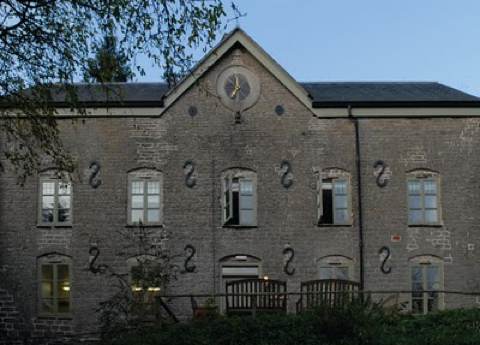Arvon Foundation:
Graphic Novel Courses

One of the more significant examples of the many ‘tipping points’ in the continuing progress of comics in Britain was the first time that the prestigious Arvon Foundation piloted one of their intensive residential writing courses specifically focussed on graphic novels in 2006. Since then, Arvon have developed this specialisation into an annual course which has proved hugely popular and productive. This June 25th to 30th at The Hurst in Shropshire (below) brings the opportunity to sign up for their latest Graphic Novels Course with tutors Bryan Talbot and Hannah Berry, both successful graphic novelists published by Jonathan Cape, and guest Mary Talbot. Later, from August 13th to 18th, Graham Rawle and Margaret Huber are the tutors for a related course on Text and Image, with guest, graphic design genius George Hardie.

To find out more about what it’s like to take part in these courses, I have asked two other former Arvon attendees to reveal their experiences and how it has affected their comics-making. My thanks to both of them for responding to my questions. First up is Katie Green, who has a major autobiographical graphic novel, Lighter Than My Shadow, about her survival of anorexia and sex abuse, currently in development with Jonathan Cape and due to be published in 2013.

Paul Gravett:
What are the Arvon Graphic Novel courses like?
Katie Green:
I really can’t speak highly enough about them. I went on the first one ever in 2006, and again in 2008. Both times I was lucky enough to receive a grant towards the cost from Arvon themselves - a lot of people aren’t aware they do that. The courses are based in an isolated country house in Shropshire, with no internet and no mobile phone reception, so you truly are cut off from the outside world - terrifying, but great if you need a kick to get that graphic novel off the back burner. They are fully residential, and all the students share the cooking (each person will have one evening where they help cook, and one where they clear up).
How are they structured?
The working days are structured with taught sessions in the morning, and free time in the afternoons. In the afternoons you can return to your private room to work, work with other people in the communal space, or skive off and go for a lovely walk. There is also the opportunity to talk to tutors on a one-to-one basis during the afternoons - possibly the most valuable part of the course of all. In the evenings, the tutors will give presentations about their work, and a third ‘visiting’ tutor will arrive for dinner and to give a presentation on the Wednesday evening. Finally, at some stage on the Friday, the students will present their work from the week to the group: nervewracking for most people, but incredible to see how much work everyone has done. It’s worth saying that the courses are geared at writing graphic novels. Many students draw as well, but it’s not a prerequisite.
What did you learn from the course?
All in all, the experience is completely unique and the list of things I took away from the courses is vast: from technical knowledge of comics (far more than I learned in three years at art college) to confidence in my work, to lifelong friends.
What tangible and emotional benefits did you get from it?
I think there’s something magical about the combination of being completely isolated, in a temporary community with people of all ages and backgrounds (and all over the world), with a deep abiding love of comics in common. I think as much is learned in the late night (and often drunken) discussions as in the classes, and as much from the support and feedback of the other students as the tutors.
How does the intensiveness of one-to-one tutorship make a big difference?
The group’s bonds continue long after the course is over: indeed I am still in touch with many fellow students, and we have even produced collaborative comics. The same is true of the tutors, who feel more like friends after a week of living under the same roof. And of course we cannot overlook the fact that an invite to Bryan Talbot’s book launch (an honour bestowed on all past students) gave me the opportunity to place my graphic novel into the hands of an editor from Jonathan Cape, who happened to like it. To find out more, I have written extensively about my Arvon experience on my blog, and there’s a short promotional film that Arvon just released that’s a great intro to their courses in general (and stars yours truly).

Children’s book illustrator Paula Knight is up next. Her graphic memoir project, The Facts of Life (above), was shortlisted in the Myriad Editions First Graphic Novel competition this year. In this, she examines the pressure placed upon women to become mothers, and what happens when life doesn’t go as planned. You can read her Director’s Commentary on a selection of pages online.
Paul Gravett:
What are the Arvon Graphic Novel courses like?
Paula Knight:
Arvon courses are ‘unreal’ in a good way. It’s akin to living in a writers’ commune with other like-minded creative people sharing a common aim for a short-but-sweet intense period - but you can keep yourself to yourself if and when you wish. I’ve attended two Arvon Foundation courses - Writing for Children in 2004 at the Ted Hughes Arvon Centre, Yorkshire, and Graphic Novels at The Hurst, Shropshire, last year.
Aside from the tutors, I always think that any course or group is as good as the people who attend it, and on both occasions I’ve been lucky enough to be part of a group that connected really well and it felt like a mutually nurturing environment. At least half of the people from the children’s writing course have since been published (including myself later this year). A few of us are in touch eight years on and one or two still support or critique one another’s work. The centres are set in remote, peaceful locations well away from mobile phone signals - and there’s no internet access. I found that this helped me immerse myself in my project without distractions. The only distraction was deciding what colour wine would help lubricate an evening of graphic novel and getting-to know-folk chat.
All food is provided but the cooking of it is ‘interesting’. On one night, you have to cook (in a group) for all of the other people on the course. Tutors are live-in and eat alongside everyone else. Arvon provide the food, menus, recipes, and assistance if needed. It’s quite nerve-wracking cooking for so many people but you find that folk are grateful for what you put in front of them - and it means you don’t have to cook for the rest of the week. Lunch is provided and you make your own breakfast. Some groups added candles and music to give dinner time that extra-special ambience.
How are they structured?
They are usually five-day residential courses starting on a Monday afternoon or eveing, which is a getting-to-know-people night. The teaching happens in the mornings leaving the afternoons free for working on personal or set projects, or doing whatever takes your fancy - exploring the locality if you wish. You have a one-to-one session with each of the two tutors during the week and they are available at other times if you need help. The tutors present their work in the evenings; on one evening there’s a guest tutor; other nights we watched DVDs about Robert Crumb, Art Spiegelman etc. We spent the last evening presenting our own work to everyone. This is an opportunity for peer feedback and to discover what others have achieved during their week.
What did you learn from the course?
Bryan Talbot took us through a pretty thorough history of the medium and a list of ‘must reads’. Months later I’m pretty much only reading graphic novels and related books. One of the best pieces of advice (from both courses) was to read widely within the medium you want to write. The most useful thing I learnt was about practical ways to help with structuring a narrative and seeing our tutors’ examples of how they did that in their own work. Hannah Berry’s hypothesis of ‘three realities’ governing the universe you create in any particular story was fascinating and new to me. I assumed my story had ‘no God’ but on closer inspection realised it does indeed have a ‘Casual God’ ... and we’re not talking religion here!
What tangible and emotional benefits did you get from it?
I came away from the course with much greater confidence in my work, which galvanised me to further develop my current project. This not only came from the tutors but from sharing my work with other students and, in turn, being inspired by their work. I’m writing a memoir and it’s not always easy talking about such personal work in front of strangers. An Arvon course is a safe place to dip your toe in the water in that respect. And, in my experience, Arvon courses are definitely a proving ground for future friendships and professional collaborations.
How does the intensiveness of one-to-one tutorship make a big difference?
It really is invaluable to get feedback from people who’ll give it honestly and who have ‘been there and got the t-shirt’ several times over. I did a longer correspondence course in writing but learnt more in my two Arvon weeks. The one-to-one contact also means you can ask anything in confidence that you might not feel comfortable about discussing with a group. Unless you’re steeped in academia, I can’t think of another opportunity to have so much access to help with your work while you’re working on it.
Posted: March 11, 2012











